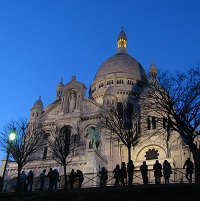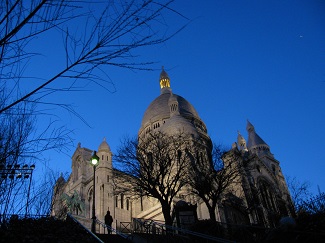
While guidebooks describe sightseeing in Paris under sunny skies, Ellen Lebelle tells of a cold, gray, back-aching shuffle through Montmartre.
by Ellen Lebelle
When it’s cold and gray in Paris, Montmartre is a bit colder and grayer than the rest of the city. When it’s cold and gray in December, you just grin and bear it and say to yourself that it’s winter, so stop complaining. But when it’s that way at the very end of March, you bear it without the grin. However, you can’t dictate the weather when you travel. It’s always either too cold or too hot or raining….
This, however, is not about the weather. This is about the shuffle. If you’ve been to a big exhibit—Monet, Matisse, Hopper, Dali—you’ve experienced it. You shuffle from one painting to the next. You try to get closer to the tiny card that identifies the piece, too low down for your aching back and in any case too badly lit. The crowd pushes you from behind and you shuffle along. You can’t get any distance from the painting either, otherwise you’ll lose your place and won’t see anything because the others are crowded so close to the wall.
This is the price of seeing art. It is also the price of major tourist attractions.

Montmartre is a major tourist attraction. When you get out of the metro at Abbesses and you see that everyone is exiting at the same station you figure you are not alone on this pilgrimage. You start the shuffle straight away.
You can’t cross the street because of the pedestrian traffic coming at you, crossing in front of you. Cars rarely venture onto these streets. There is a long line for the funicular and you’re squashed like sardines, but you make it to the top, where there is a bit of a jam trying to get out and over to the steps with a view of the white fog over Paris. You can’t see any major monuments, though, on such a gray day, and it’s hard to stay out of the way of people taking pictures of their loved ones on the steps.
The human statues are always amusing; you wonder if anyone leaves them money—you don’t. There is a harpist playing in the cold and then, further up, a violinist played classic French hits. With all this entertainment, you have to keep counting off your own group: six adults and two small children who kept changing places among the grown-ups.
You get into line to enter Sacré Coeur; only one gate is open for both ingoing and outgoing traffic, which causes another traffic jam. The basilica is cold and dark—19th century neo-Romanesque architecture, none of that light, airy Gothic of Notre-Dame. From afar it looks like a meringue topping on the hill, but up close it’s too big to take in. There are so many people you shuffle along, down the left side and back up the right, without much time to notice anything of particular interest or beauty, leaving you with the impression there isn’t any. There are very clear signs asking tourists to respect the place (no photos) and the people who might be praying (silence), but it’s clear that most visitors ignore the signs; even when a staff person puts his hand in front of someone’s camera to stop him from taking a picture, it only works until the staffer goes onto the next person. Once your little group had collected itself together to leave, it takes another few minutes to negotiate the exit traffic jam and cross through the line waiting to go in.

Between the basilica and the Place du Tertre, you may need to stop to eat. First, there is a big traffic jam of people watching the organ lady grind her mechanical organ and sing à la Piaf. You can hear her but not see her—too many people. You have lunch where everyone has lunch, which has satisfied your appetite but not your aching back, and by the time you leave it has started to snow. So now under snowfall you continue the shuffle through the pedestrian traffic to the Place du Tertre to admire the artists hard at work. You are impressed by some, but not to the point of sitting for a portrait; it’s too cold and there were too many people milling about. So you duck into a gallery to get warm and to figure out the rest of the day. You make a plan: two of the adults will take the kids home while the others go to the Flea Market at St. Ouen, a place you wouldn’t venture to in winter, even when it’s officially spring.
Then you work your way down the hill of Montmartre, again with the shuffle. It’s the same shuffle in museums, at Mont St. Michel, at Notre-Dame, in Rome, in Florence, in New Hope and along the Great Wall of China. The same shuffle, but as you get older, it only gets worse.
© 2013, Ellen Lebelle
Ellen Lebelle is an American who has lived in France for a long, long time. She is a wife and mother of four enjoyable adults. A former technical writer and English teacher, she is now retired.
Also see The Cranky Parent, The Cranky Urbanist, The Cranky Foreign Resident and The Cranky Pedestrian.

